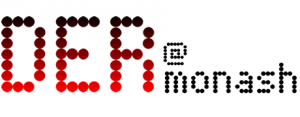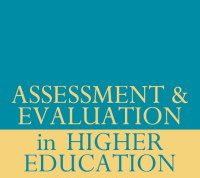This response was prepared by Dr. Katrina Tour
@katrina_tour on behalf of the Digital Education Research (DER) group @ Monash – the PDF version can be downloaded below.
Overview
The Digital Education Research group from the Faculty of Education, Monash University contains around twenty academic researchers and educators focused on digital technologies and education. As such we welcome the opportunity to respond to the proposed EAL Curriculum in light of our specific interest and expertise.
Overall, then, we welcome the acknowledgement in the new EAL curriculum that digital technologies have altered (and continue to alter) the nature of language and literacy leading to the emergence of “digital literacies”. In this sense, it is appropriate that the curriculum document frequently refers to the notion of “digital texts” and identifies a number of digital skills and understandings that EAL students need to develop.
However, we feel that the focus on digital teaching and learning in the curriculum can be further enhanced and improved in a number of ways. These will be essential if the curriculum is to be successful in achieving its stated aims to develop EAL students’ English language skills “for effective communication, for successful interaction and for access to learning” (VCAA, 2019, p.4) at school and in everyday life in Australia.
It has been widely acknowledged that digital literacies are crucial for language learners not only to integrate into a new country and participate in school life successfully but also to “unlock” and maximise opportunities for independent language learning with digital technologies beyond classrooms. Language learners have new needs in the digital age and they need teachers’ support to develop relevant capabilities to be able to read, write and communicate in digital spaces for different purposes in a new language (Center for Multicultural Youth, 2017; Hafner, 2019; Sauro & Zourou, 2019).
Areas for improvement
In the light of this, we wish to draw attention to four specific areas for revision and elaboration in the final curriculum document:
- Provide more detailed content descriptors and examples
As it currently stands, the proposed EAL curriculum needs (1) a more detailed description of the content related to digital literacies, and (2) a wider range of examples throughout the document. It is important to provide a more elaborated discussion of what exactly students need to learn about digital reading, writing and communication at different levels. If “the EAL curriculum has been designed to be accessible to all teachers” (VCAA, 2019, p.4), it needs to support practitioners in teaching digital literacies more effectively. Vague descriptions without clear examples can be problematic because they leave it up to the individual teachers to interpret what “digital” means. It cannot be assumed that all teachers can easily identify and effectively sequence the capabilities that should be taught when engaging EAL students with technology and digital texts.
The research evidence suggests that digital literacies are often marginalised in language classrooms because teachers are not prepared for these practices (Hafner, 2019; Lotherington & Jenson, 2011; Tan & McWilliam 2009). Without sufficient guidance in the curriculum, practitioners will remain hesitant to include digital literacies in their practices. As a result, language learners will learners will miss valuable opportunities to mobilise existing and new skills.
Some examples of such vague descriptions are illustrated below:
| Example of the content descriptors from the curriculum | Comments |
| Use a range of digital formats and images to enhance meaning and impact (p.40) | It may be unclear to the teachers what is exactly meant by “digital formats”. |
| Level BL: Demonstrate basic keyboard skills; for example, use the shift key, space bar and mouse, and use basic word-processing software Level B1: Produce written texts using a computer (p. 26) | What skills, knowledge and understandings do students need to develop at Level B1 as compared to Level BL? What kinds of texts? Different texts require different skills. |
| They use basic wordprocessing features to write and present their texts (p. 41) | What counts as “basic” and in what contexts? Furthermore, there are many different word processing apps and software which may differ in terms of capabilities they require. |
| Digital language (Glossary, p.56) | The concept is mentioned in the glossary without sufficient explanations or examples. It assumes something “universal” which is problematic because the use of language in digital spaces is shaped by contexts, audiences and social purposes. No reference to “digital language” was found in the document. |
In comparison to many other content descriptors (e.g. use of punctuation – p. 40), these broad descriptions of the digital experiences are insufficient and can be confusing for teachers. We would recommend the inclusion of more specific, detailed and well-sequenced descriptors in relation to digital literacies across different levels
2. Incorporate digital literacies more consistently
Some parts of the curriculum can be enhanced by further reference to digital literacies. For example, the section “Writing – Level C” (p. 37-40) has a significant focus on print-based skills disregarding that writing and communication are often digital these days. Of course, print-based literacy is central to writing in digital spaces but it is important to acknowledge that the nature of digital forms of writing and communication is different from print-based and these practices require many additional skills and understandings. Moreover, engaging in digital writing and communication can provide students with limited English creative ways of extending their understanding of language. Using different affordances of digital technologies can strengthen ways that EAL students take risks, extend language capabilities and build communicative confidence.
A significant body of research emphasises that digital writing and communication are characterised by a distinctive “ethos” (Lankshear and Knobel, 2011, p. 55) as compared to traditional print-based forms. Writing in digital spaces is often associated with social interaction, participation, taking active roles, generating and distributing multimodal content, connectivity, collaboration, shared expertise, creativity, improvisation as well as dynamic, ever-changing and non-linear practices (Jones & Hafner, 2012; Kalantzis, Cope, Chan, & Dalley‐Trim, 2016).
The more exposure and practice students have with multiple digital genres, registers and contexts, the more likely they will be prepared for digital literacy practices within and outside of school. Some examples of how the current version of the curriculum can be further enhanced are outlined below:
| Example of the content descriptors from the curriculum | Comments |
| Identify and compare differences between text types (such as recount, report, procedure, narrative) (p.21) | This description can be enhanced by including some examples of digital texts (e.g. slideshow, webpage, podcast, video, etc.). |
| Write simple, longer personal texts, such as letters of invitation, thanks to visitors, journal entries, emails (p.24) | There is a need to include other forms of digital writing beyond email: the forms which are central to EAL students’ everyday lives and learning at school. |
| Interact socially with peers and familiar adults in most informal school contexts (p.28) | This can also mention the digital channels of communication, associated social protocols and language that are used by students for socialising and even completing school work. |
| Use some of the terminology of reading, such as author, title, letter, word, sentence (p.22) | It would be helpful to include the terminology associated with reading online to prepare students for the complexity of these reading practices. |
3. Emphasise critical digital literacy
It would be also valuable to emphasise the importance of ‘critical literacy’ in relation to digital reading, writing and communication throughout the document. A critical dimension of digital literacies is important more than ever these days and it will empower EAL learners in many ways.
Rowsell, Morrell and Alvermann (2017) emphasise that “we need to ensure that we are using digital tools critically in our classrooms and providing all students access to learning that will make them more informed and reflective consumers, producers and distributors of digital content” (p.161).
This emphasis may include the following ideas:
- Learning how to problematise, critique and be sceptical about digital platforms, texts, interactions and relationships
- Recognising how users are positioned in digital practices and can be manipulated by digital platforms, texts, relationships and language
- Learning how to use language, texts and technology for one’s own purpose, goals and advantage.
4. Refer to digital literacies in the diagnostic interview template and case studies
A final area which can be further enhanced is the diagnostic interview template and case studies. These resources can include some prompts to gain information about students’ prior knowledge of and access to digital technologies and digital literacies. While some EAL students may have a range of digital skills and engage in digital literacies on a regular basis at home or school in their home country, a significant number of EAL students, especially those from disadvantaged backgrounds, may have very little (if at all) experience/exposure to technology and learning digital literacies.
Young people from refugee and migrant backgrounds arrive in Australia with an incredibly diverse range of skills and experiences that determine how well prepared they are to navigate settlement in an intensely digital environment. However, during their first five years of settlement, the refugee and migration experience appears to present additional challenges to their digital inclusion (Centre for Multicultural Youth, 2017, p. 6).
While all EAL students need teachers’ scaffolding to learn how to read, write and communicate in digital spaces in a new language and new socio-cultural contexts, some students may require additional support to narrow the digital divide in terms of their skills. They may need knowledge, skills and understandings that other students take for granted. Including the gathering of some information about EAL learners’ digital experiences will further assist schools and individual teachers.
References
- Centre for Multicultural Youth (2017). Settlement in the digital age. Retrieved from https://www.cmy.net.au/sites/ default/files/ publication-documents/Settlement %20in%20the %20digital%20age_Jan2017_0.pdf
- Jones, R., & Hafner, C. (2012). Understanding digital literacies: A practical introduction. New York, NY: Routledge.
- Hafner, C. (2019). Digital literacies for English language learners. In X. Gao (Ed.), Second handbook of English language teaching (pp.1-20). Springer International Handbooks of Education.
- Kalantzis, M., Cope, B., Chan, E., & Dalley-Trim, L. (2016). Literacies. Port Melbourne, VIC, Australia: Cambridge University Press.
- Lotherington, H., & Jenson, J. (2011). Teaching multimodal and digital literacy in L2 settings: New literacies, new basics, new pedagogies. Annual Review of Applied Linguistics, 31, 226–246.
- Rowsell, J., Morrell, E., & Alvermann, D. E. (2017). Confronting the digital divide: Debunking brave new world discourses. The Reading Teacher, 71(2), 157-165.
- Sauro, S., & Zourou, K. (2019). What are the digital wilds? Language Learning & Technology, 1(23), 1-7.
- Tan, J. P.‐L., & McWilliam, E. (2009). From literacy to multiliteracies: Diverse learners and pedagogical practice. Pedagogies, 4, 213–225.
- Victorian Curriculum and Assessment Authority (2019). English as an Additional Language Curriculum: Draft for familiarisation, feedback and optional implementation. Retrieved from https://www.vcaa.vic.edu.au/Documents/viccurric/eal/English%20as%20an%20Additional%20Language%20Curriculum%20%E2%80%93%20Draft.pdf
Acknowledgement
I would like to acknowledge Dr Carlo Perrotta, Prof Neil Selwyn and Dr Julia Faulkner for their insightful suggestions and comments.







